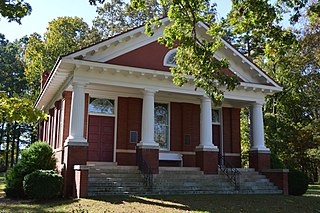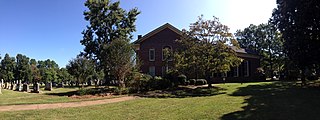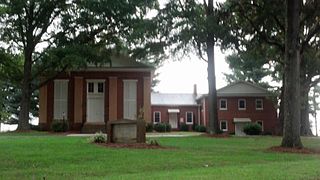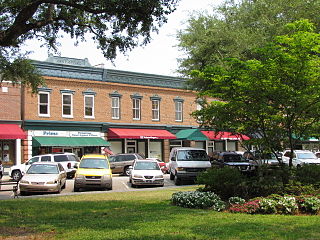
Hawfields Presbyterian Church is a historic Presbyterian church complex located near Mebane, Alamance County, North Carolina. The congregation was established by settlers in the 1700s. The complex consists of the original church building, the classroom to the rear of it, the Session House, and the cemetery. The current Greek Revival style brick church building was constructed between 1852 and 1855.

Mt. Horeb Presbyterian Church and Cemetery is a historic Presbyterian church and cemetery located near Elizabethtown, Bladen County, North Carolina. It was built in 1845, and is a frame Greek Revival-style church with a pedimented front portico added in 1932.

Rocky River Presbyterian Church is a historic Presbyterian church located near Rocky River, Cabarrus County, North Carolina. The property includes the Greco-Italianate style brick church (1860-1861); a frame Session House (1839); a small cemetery dating to 1814; and the two-story, brick Greek Revival and Italianate style Manse (1873).

Griers Presbyterian Church and Cemetery is a historic Presbyterian church and cemetery located near Frogsboro, Caswell County, North Carolina. It was built about 1856, and is a simple, rectangular frame building. It is an example of Greek Revival temple-form church architecture. Also on the property is a contributing church cemetery.

Red House Presbyterian Church, also known as Hugh McAden Gravesite or Red House Church, is a historic Presbyterian church and cemetery located at 13409 NC 119 N in Semora, Caswell County, North Carolina. The Classical Revival red brick church building was constructed in 1913. It features a portico with four round, fluted wooden Doric order columns. Also on the property is a contributing church cemetery.

Big Rockfish Presbyterian Church is an historic Presbyterian church located at Hope Mills, Cumberland County, North Carolina. It was built in 1855, and is a two-story, three bay by four bay, gable-end frame building with double front entrances in the vernacular Greek Revival style.

The Buffalo Presbyterian Church and Cemetery in Greensboro, Guilford County, North Carolina, United States, is a historic Presbyterian church complex and cemetery located at 800 and 803 Sixteenth Street in Greensboro. The Federal-style church sanctuary was built in 1827, and updated and expanded in 1919–1920 in the Colonial Revival style by architect Harry Barton (1876-1937). It was expanded again in 1956. Flanking the sanctuary are two-story Colonial Revival-style educational buildings linked to it by one-story arcades. The rectangular two-story Colonial Revival-style manse and garage were added to the complex in 1924. The church cemetery has burials dating back to 1775.

Bethesda Presbyterian Church, Session House and Cemetery is a historic Presbyterian church, session house, and cemetery located in Chambersburg Township, Iredell County, North Carolina. It was built in 1853, and is a one-story, three bay by five bay, rectangular vernacular Greek Revival style frame church. It has a pedimented, temple form, front gable roof and an unusual front recessed balcony. It is the oldest church building in Iredell County. Also on the property is the contributing session house, also built in 1853, and church cemetery with about 200 gravestones.

Ebenezer Academy, Bethany Presbyterian Church and Cemetery is a historic school building, Presbyterian church, and cemetery located six miles north of Statesville in Bethany Township, Iredell County, North Carolina. The log building was constructed in 1823 and housed Ebenezer Academy. The church building was built about 1855, and is a one-story, three bay by five bay, vernacular Greek Revival style frame building with a low gable roof. Also on the property is the contributing church cemetery with burials dating to about 1785.

Centre Presbyterian Church, Session House and Cemeteries is a historic Presbyterian church, session house, and cemetery located near Mount Mourne, Iredell County, North Carolina. The original church building was constructed in 1765, but was destroyed by fire. The current church building and session house were constructed 1854. The church is a one-story, three bay by four bay, rectangular vernacular Greek Revival style brick church. The church's cemetery contains gravestones dating to the 18th century.

Buffalo Presbyterian Church and Cemeteries is a historic Presbyterian church and cemeteries located at 1333 Carthage Street in Sanford, Lee County, North Carolina. It was built in 1879, and is a two-story, gable-fronted, Gothic Revival style frame building. The front facade features lancet-arched double-leaf entries, lancet-arched windows, and a three-stage projecting entry tower with a flared, pyramidal roof and finial. Associated with the church is the manse built in 1926. It is a two-story, hip-roofed frame dwelling with Colonial Revival detailing. Also on the property are the original church cemetery, a cemetery for African-American congregants, the Matthews family plot, and the main cemetery. It is the oldest Presbyterian Church in Lee County, Sanford, North Carolina. This is an active congregation of the Presbyterian Church USA.

Hopewell Presbyterian Church is a historic Presbyterian church complex and national historic district located near Huntersville, Mecklenburg County, North Carolina. The church was built in 1833–1835, renovated and enlarged in 1859–1860, and expanded by a Sunday School addition in 1928. It is a U-shaped brick and brick veneer building composed of three connected blocks all covered with front-gable roofs. The church is a rectangular gable-front brick building standing on a low mortared fieldstone foundation and Greek Revival style design elements. Also on the property are the contributing pumphouse, cemetery gate (1845), and cemetery with burials dating to 1775. The cemetery contains one of the two largest collections of box and chest tombs in North Carolina. General William Lee Davidson of the North Carolina militia, killed in 1781 at the Battle of Cowan's Ford during the American Revolutionary War, is buried in the cemetery.

Ramah Presbyterian Church and Cemetery is a historic Presbyterian church and cemetery located near Huntersville, Mecklenburg County, North Carolina. The current church sanctuary was built in 1881, and is a rectangular, gable-front vernacular Greek Revival / Italianate style frame building. It is three bays wide and has segmental-arched, double-hung sash windows and a tall rectangular and segmental-arched louvered vent. Also on the property is a one-story, log Fellowship Building built in 1935. The cemetery contains approximately 500 burials, with the oldest dating to about 1800.

Steele Creek Presbyterian Church and Cemetery is a historic Presbyterian church complex and national historic district located near Charlotte, Mecklenburg County, North Carolina. The church was founded in 1760 and the current sanctuary was built in 1889, and is a rectangular, Gothic Revival style brick building. It is five bays wide and six bays deep, and has pointed-arched sash windows, shallow buttresses, and steeply pitched roof parapet. The cemetery contains approximately 1,700 headstones, with the oldest dating to 1763.

Back Creek Presbyterian Church and Cemetery is a historic Presbyterian church and cemetery in Mount Ulla, Rowan County, North Carolina currently affiliated with the Presbyterian Church in America (PCA). It was named for a nearby stream, which was back of Sills Creek and called Back Creek.

Black River Presbyterian and Ivanhoe Baptist Churches are historic Presbyterian and Baptist churches located on SR 1102 east of SR 1100 in Ivanhoe, Sampson County, North Carolina. Associated with each church is a cemetery. Among the founders of the Black River Presbyterian congregation were immigrants, from Isle of Arran, Patrick Murphy (1720-1785) and Elizabeth Kelso (1724-1798), who are buried in the Black River Presbyterian Church Cemetery. The original wooden markers for these graves, now in Sampson County History Museum, were replaced by marble stones. The current Black River Presbyterian Church structure was built in 1859, and is a one-story, temple form, Greek Revival style frame church with an impressive pillared portico. The Ivanhoe Baptist Church was built in 1893 or 1895, and is a vernacular Gothic Revival style frame church. The Presbyterian congregation was founded in 1740 by Scots from the Island of Arran and from mainland Scotland.
Oak Plain Presbyterian Church is a historic Presbyterian church located near Waycross, Sampson County, North Carolina. It was built in 1859, and is a one-story, three-bay-by-three bay, temple form, Greek Revival style frame church. A steeple was added to the church building in 1976. Also on the property is the contributing church cemetery.

The Greensboro History Museum, consisting of the former First Presbyterian Church of Greensboro and Smith Memorial Building, is a historic museum building located at 130 Summit Ave. in Greensboro, Guilford County, North Carolina. The former Presbyterian church was built in 1892 on the site of a former Confederate hospital, and is a Romanesque Revival style brick building with a cross gable roof and tower. The semi-circular, 11 bay, Smith Memorial Building was built in 1903. It features four octagonal sides and a tower. The memorial building was designed by the architect Charles Christian Hook (1870-1938). The church and memorial building were connected and the older structures modified and renovated in 1938. Also located on the property is the First Presbyterian Church cemetery, established in 1831, after the first church was built on land that was donated by Jesse H. Lindsay. The church vacated the property in 1929, and in 1937-1938 it was renovated and enlarged as the Richardson Civic Center and donated to the city of Greensboro. It subsequently housed the Greensboro Public Library, the Greensboro Historical Museum, and the Greensboro Art Center. The historic building functions as one part of the current, larger Greenboro History Museum.

Summerville Historic District is a national historic district located at Summerville, Dorchester County, South Carolina. The district encompasses 700 contributing buildings in the village of Summerville. About 70 percent of the buildings predate World War I. The buildings include raised cottages, Greek Revival influenced, and Victorian / Queen Anne and other turn of the 20th century structures are found throughout. In addition to residential structures, the district includes churches and commercial buildings—most dating from around 1900. Notable buildings include Tupper's Drug Store, O. J. Sire's Commercial Building, White Gables, Pettigru-Lebby House Gazebo, Summerville Presbyterian Church, Wesley United Methodist Church, and the Squirrel Inn.
Hebron Presbyterian Church, also known as Sutton's Branch Church, is a historic Presbyterian church and national historic district located near Beautancus, Duplin County, North Carolina. The district encompasses one contributing building and one contributing site. The church was built in 1890, and is a small one-story, front-gable, wood-frame Late Gothic Revival-style church. Also on the property is the contributing church cemetery with burials dating to 1902.






















